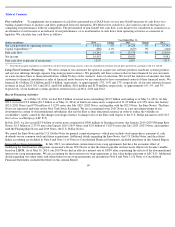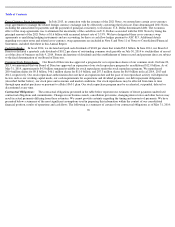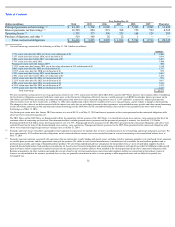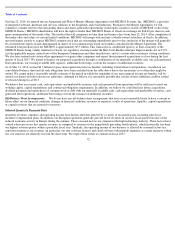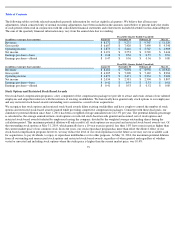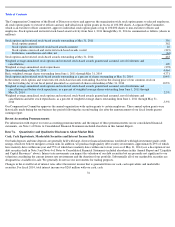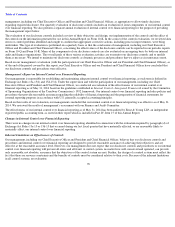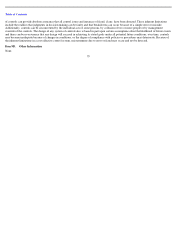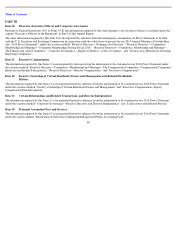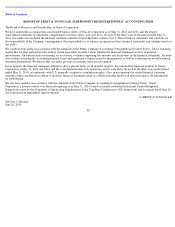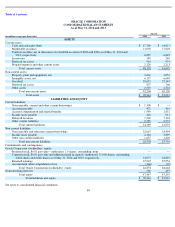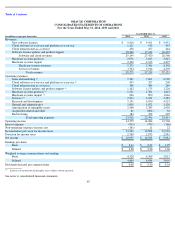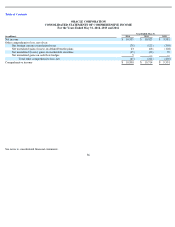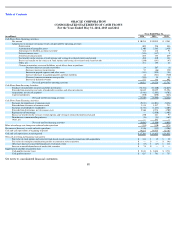Oracle 2013 Annual Report Download - page 82
Download and view the complete annual report
Please find page 82 of the 2013 Oracle annual report below. You can navigate through the pages in the report by either clicking on the pages listed below, or by using the keyword search tool below to find specific information within the annual report.
Table of Contents
management, including our Chief Executive Officer and President and Chief Financial Officer, as appropriate to allow timely decisions
regarding required disclosure. Our quarterly evaluation of disclosure controls includes an evaluation of some components of our internal control
over financial reporting. We also perform a separate annual evaluation of internal control over financial reporting for the purpose of providing
the management report below.
The evaluation of our disclosure controls included a review of their objectives and design, our implementation of the controls and the effect of
the controls on the information generated for use in this Annual Report on Form 10-K.
In the course of the controls evaluation, we reviewed data
errors or control problems identified and sought to confirm that appropriate corrective actions, including process improvements, were being
undertaken. This type of evaluation is performed on a quarterly basis so that the conclusions of management, including our Chief Executive
Officer and President and Chief Financial Officer, concerning the effectiveness of the disclosure controls can be reported in our periodic reports
on Form 10-Q and Form 10-K. Many of the components of our disclosure controls are also evaluated on an ongoing basis by both our internal
audit and finance organizations. The overall goals of these various evaluation activities are to monitor our disclosure controls and to modify
them as necessary. We intend to maintain our disclosure controls as dynamic processes and procedures that we adjust as circumstances merit.
Based on our management’s evaluation (with the participation of our Chief Executive Officer and our President and Chief Financial Officer), as
of the end of the period covered by this report, our Chief Executive Officer and our President and Chief Financial Officer have concluded that
our disclosure controls and procedures were effective.
Management
’s Report on Internal Control over Financial Reporting
Our management is responsible for establishing and maintaining adequate internal control over financial reporting, as such term is defined in
Exchange Act Rules 13a-15(f) and 15d-15(f). Under the supervision and with the participation of our management, including our Chief
Executive Officer and President and Chief Financial Officer, we conducted an evaluation of the effectiveness of our internal control over
financial reporting as of May 31, 2014 based on the guidelines established in Internal Control—Integrated Framework issued by the Committee
of Sponsoring Organizations of the Treadway Commission’
s 1992 framework. Our internal control over financial reporting includes policies and
procedures that provide reasonable assurance regarding the reliability of financial reporting and the preparation of financial statements for
external reporting purposes in accordance with U.S. generally accepted accounting principles.
Based on the results of our evaluation, our management concluded that our internal control over financial reporting was effective as of May 31,
2014. We reviewed the results of management’s assessment with our Finance and Audit Committee.
The effectiveness of our internal control over financial reporting as of May 31, 2014 has been audited by Ernst & Young LLP, an independent
registered public accounting firm, as stated in their report which is included in Part IV, Item 15 of this Annual Report.
Changes in Internal Control over Financial Reporting
There were no changes in our internal control over financial reporting identified in connection with the evaluation required by paragraph (d) of
Exchange Act Rules 13a-15 or 15d-15 that occurred during our last fiscal quarter that have materially affected, or are reasonably likely to
materially affect, our internal control over financial reporting.
Inherent Limitations on Effectiveness of Controls
Our management, including our Chief Executive Officer and President and Chief Financial Officer, believes that our disclosure controls and
procedures and internal control over financial reporting are designed to provide reasonable assurance of achieving their objectives and are
effective at the reasonable assurance level. However, our management does not expect that our disclosure controls and procedures or our internal
control over financial reporting will prevent all errors and all fraud. A control system, no matter how well conceived and operated, can provide
only reasonable, not absolute, assurance that the objectives of the control system are met. Further, the design of a control system must reflect the
fact that there are resource constraints and the benefits of controls must be considered relative to their costs. Because of the inherent limitations
in all control systems, no evaluation
78



